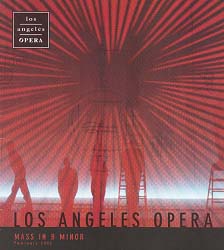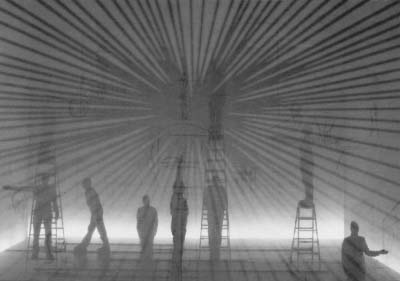LOS ANGELES-- Johann
Sebastian Bach's MASS IN B MINOR was mounted recently by Los Angeles Opera
in an adventurous and memorable
production, thanks largely to the radical vision of director/designer
Achim Freyer. Freyer, who was born in Berlin in 1934 and is a disciple
of Bertolt Brecht, left the Berlinner Ensemble in 1972 and crossed to
the west, where he rapidly became known as an innovative stage director,
one who was strongly influenced by the visual arts.

Freyer has also had a career as a painter, with numerous solo and group
exhibitions to his credit, but of late he has concentrated on directing
opera. All his many gifts were on display in MASS IN B MINOR, a sacred
work usually mounted in traditional concert-hall fashion. Freyer, however,
first explored the work's visual and dramatic possibilities in a 1996
production at the Schwetzingen Festival which came to Placido Domingo's
attention. Domingo, artistic director of Los Angeles Opera, asked Freyer
to recreate his work in California.
Featuring four imported
singers plus an ensemble of stage figures (members of Freyer's own theatre
group) backed up by the Los Angeles Chorus, MASS IN B MINOR proved a feast
for the eye as well as the ear and mind. The singers (and orchestra) were
stationed in the pit; the stage was dominated by a white box fronted by
a painted scrim through which mysterious stage figures could be seen,
most of the time in silhouette. Moving slowly yet gracefully, resembling
moon men or Giacometti notations, the figures did not try and visually
duplicate the text, but complemented it in highly abstracted yet arresting
fashion.

Alan Burrett's lighting greatly enhanced this other-worldly vision, with shadows giving way at times to lush crimson and startling orange that suggested the colors of creation. In all, the visual elements helped the MASS take on varying dimensions and moods, ones that matched the text's cries from the depths of humanity, its pleas for God's mercy, understanding and compassion. The fusion of music, voice and sight provoked one's sensibilities into reacting to the MASS in new and unaccustomed ways.

Domingo, during a recent press conference, had promised that Los Angeles
Opera would strike out in new, bold directions in future. He certainly
backed up his words with this cutting-edge production. Domingo also promised
to present a world premiere in each season to come, with new works in
the offing as well, including a Deborah Drattell work in 2003, one by
John Williams in 2004, and a production in 2005 from director Julie Taymor
and composer Elliot Goldenthal.
Domingo also reaffirmed his love of Zarzuela--Spanish and Latin American operettas. "There is a place for them here in Los Angeles," he said, "if only because of the city's large Latino population. I want to put on a full production of a zarzuela as soon as possible, if not at the Music Center, then in another large theatre in downtown Los Angeles."
Domingo added that in future he intends to offer two lyric concerts a year, "with the orchestra on stage--and preferably with Kent Nagano conducting."
The 2002-2003 season
includes three company premieres: Nabucco, War and Peace and Luciano Berio's
The Coronation of Poppea; five productions new to L.A.; revivals of The
Barber of Seville and The Flying Dutchman, and
a recital by Frederica von Stade.
For full informations click on www.losangelesopera.com